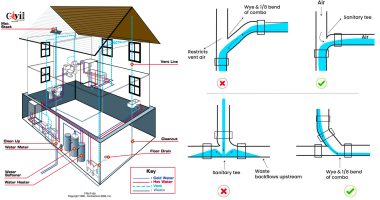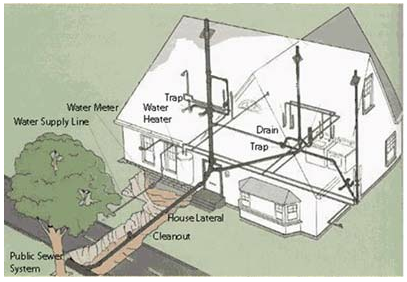A Guide to Your Property's Plumbing System Anatomy
A Guide to Your Property's Plumbing System Anatomy
Blog Article
What are your ideas on Understanding Your Home's Plumbing Anatomy?

Understanding just how your home's pipes system functions is crucial for every property owner. From delivering clean water for alcohol consumption, food preparation, and showering to securely getting rid of wastewater, a properly maintained plumbing system is important for your household's health and wellness and convenience. In this detailed overview, we'll discover the intricate network that makes up your home's plumbing and offer suggestions on maintenance, upgrades, and handling usual concerns.
Intro
Your home's pipes system is greater than simply a network of pipelines; it's a complicated system that ensures you have access to clean water and efficient wastewater elimination. Recognizing its elements and how they work together can help you avoid costly repairs and guarantee everything runs efficiently.
Standard Parts of a Plumbing System
Pipelines and Tubes
At the heart of your plumbing system are the pipes and tubing that carry water throughout your home. These can be made of various materials such as copper, PVC, or PEX, each with its benefits in terms of sturdiness and cost-effectiveness.
Components: Sinks, Toilets, Showers, and so on.
Fixtures like sinks, toilets, showers, and bath tubs are where water is made use of in your house. Understanding just how these components link to the pipes system aids in diagnosing problems and intending upgrades.
Valves and Shut-off Factors
Shutoffs manage the flow of water in your plumbing system. Shut-off shutoffs are vital throughout emergencies or when you require to make repair services, enabling you to separate parts of the system without interfering with water flow to the whole home.
Water Supply System
Key Water Line
The primary water line connects your home to the metropolitan water supply or a personal well. It's where water enters your home and is distributed to different components.
Water Meter and Pressure Regulatory Authority
The water meter measures your water use, while a stress regulator makes sure that water flows at a risk-free stress throughout your home's plumbing system, avoiding damages to pipes and fixtures.
Cold Water vs. Warm water Lines
Understanding the distinction in between cold water lines, which supply water straight from the main, and hot water lines, which bring heated water from the water heater, assists in troubleshooting and planning for upgrades.
Water drainage System
Drain Water Lines and Traps
Drain pipelines carry wastewater away from sinks, showers, and bathrooms to the sewage system or septic tank. Catches protect against sewer gases from entering your home and likewise catch debris that might create clogs.
Air flow Pipelines
Air flow pipes enable air right into the water drainage system, avoiding suction that can reduce water drainage and cause catches to vacant. Proper ventilation is necessary for keeping the honesty of your pipes system.
Importance of Proper Drainage
Making sure correct drainage avoids backups and water damage. On a regular basis cleansing drains and maintaining traps can avoid costly repair work and prolong the life of your plumbing system.
Water Heater
Sorts Of Hot Water Heater
Water heaters can be tankless or conventional tank-style. Tankless heating units warm water on demand, while storage tanks store heated water for instant usage.
Updating Your Pipes System
Factors for Updating
Updating to water-efficient components or changing old pipelines can improve water top quality, lower water costs, and raise the worth of your home.
Modern Pipes Technologies and Their Advantages
Check out modern technologies like clever leakage detectors, water-saving commodes, and energy-efficient water heaters that can conserve cash and minimize ecological influence.
Price Factors To Consider and ROI
Compute the ahead of time prices versus lasting financial savings when taking into consideration pipes upgrades. Lots of upgrades pay for themselves through decreased utility bills and less fixings.
Just How Water Heaters Attach to the Pipes System
Comprehending exactly how water heaters connect to both the cold water supply and warm water circulation lines assists in diagnosing issues like not enough warm water or leaks.
Maintenance Tips for Water Heaters
Consistently purging your hot water heater to eliminate sediment, examining the temperature level settings, and inspecting for leakages can prolong its lifespan and boost energy efficiency.
Common Pipes Problems
Leaks and Their Causes
Leakages can happen because of maturing pipelines, loose fittings, or high water pressure. Dealing with leakages without delay avoids water damages and mold growth.
Obstructions and Obstructions
Clogs in drains pipes and bathrooms are usually brought on by flushing non-flushable things or an accumulation of grease and hair. Making use of drain screens and bearing in mind what decreases your drains can stop blockages.
Signs of Plumbing Problems to Expect
Low water stress, slow drains pipes, foul odors, or unusually high water costs are indications of potential pipes problems that must be addressed without delay.
Plumbing Upkeep Tips
Regular Assessments and Checks
Schedule yearly plumbing assessments to catch problems early. Seek indications of leakages, corrosion, or mineral accumulation in taps and showerheads.
DIY Upkeep Tasks
Simple jobs like cleaning faucet aerators, looking for bathroom leakages using color tablet computers, or protecting revealed pipes in chilly environments can avoid significant pipes issues.
When to Call an Expert Plumber
Know when a plumbing problem calls for expert know-how. Trying complex repair services without correct knowledge can cause even more damage and greater fixing costs.
Tips for Decreasing Water Use
Simple practices like dealing with leaks immediately, taking much shorter showers, and running complete loads of laundry and recipes can save water and reduced your utility bills.
Eco-Friendly Plumbing Options
Think about lasting pipes products like bamboo for flooring, which is durable and environment-friendly, or recycled glass for kitchen counters.
Emergency Preparedness
Steps to Take Throughout a Pipes Emergency situation
Know where your shut-off shutoffs are located and how to shut off the supply of water in case of a ruptured pipe or significant leakage.
Relevance of Having Emergency Situation Contacts Handy
Keep contact info for regional plumbing professionals or emergency situation solutions easily offered for fast action throughout a plumbing dilemma.
Environmental Effect and Conservation
Water-Saving Components and Home Appliances
Setting up low-flow faucets, showerheads, and toilets can significantly decrease water usage without compromising performance.
DIY Emergency Fixes (When Appropriate).
Short-term fixes like using air duct tape to spot a dripping pipeline or putting a container under a leaking faucet can reduce damages till a specialist plumbing technician shows up.
Final thought.
Understanding the makeup of your home's pipes system empowers you to keep it efficiently, saving time and money on repairs. By following normal upkeep regimens and staying informed about modern-day pipes technologies, you can ensure your pipes system runs effectively for many years to come.
Understanding Your Home Plumbing System: A Comprehensive Guide
Plumbing System: The Lifeline of Your Home
At its core, the plumbing system is designed to perform two primary functions: bring fresh water into your home and remove wastewater. The system is a network of pipes, fixtures, and other components that transport water and sewage. Residential plumbing systems include potable water supply lines, drain-waste-vent (DWV) systems, and various plumbing fixtures that make water use in daily tasks possible.
Key Components:
Water Supply: This part of your plumbing system brings municipal water into your home, passing through the main water supply line. It s responsible for supplying all water needs, from drinking to bathing.
Drainage System: It carries waste and water away from your home to the sewer or septic system. This system includes all the piping within your home that leads to external sewage or septic systems.
Vent System: An essential yet often overlooked component, the vent system allows sewer gases to escape and lets air into the drainpipes, ensuring water and waste move correctly through the system.
Fixture: More Than Just Taps and Toilets
Plumbing fixtures are the most interactive parts of the plumbing system, including faucets, showers, toilets, and sinks. Each fixture is connected to the plumbing system and plays a role in either the delivery of freshwater or the disposal of waste and wastewater.
Types of Fixtures:
Faucets and Sinks: Used for washing hands, dishes, and other daily water needs. Toilets: Dispose of human waste through the sewage system. Bathtubs and Showers: Provide bathing facilities, requiring both hot and cold water supply. Water Supply: The Source of Life
The water supply system is a critical component, ensuring that potable water is available throughout your home for various uses, including drinking, cooking, and cleaning. This system consists of pipes that distribute water to different parts of the house, controlled by valves to regulate the water flow.
Types of Plumbing: Materials and Methods
Various types of plumbing systems and materials are used in residential settings, each with its advantages and applications. From copper and PVC pipes for water supply to cast iron and ABS for drainage, the choice of materials can impact the longevity and efficiency of your plumbing system.
https://intownplumbingtx.com/articles/home-plumbing-system-guide/

As an avid person who reads about Plumbing Installation 101: All You Need to Know, I imagined sharing that piece of content was smart. Sharing is good. Helping people is fun. I take joy in your readership.
Call Us Today Report this page